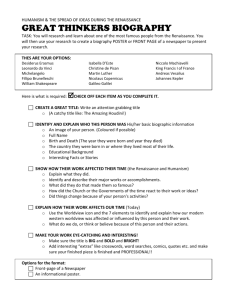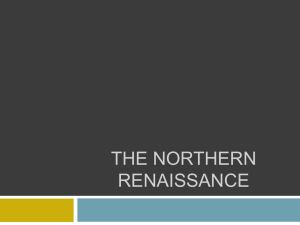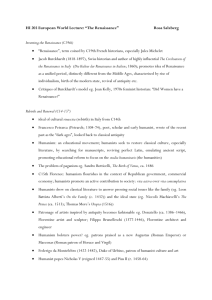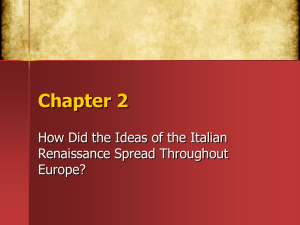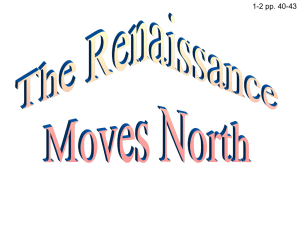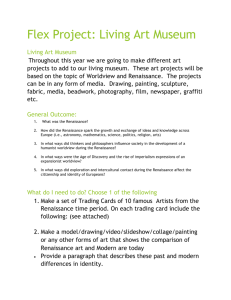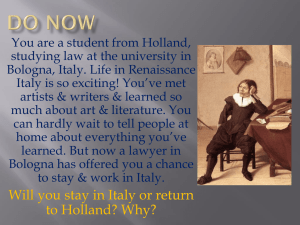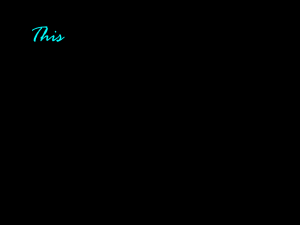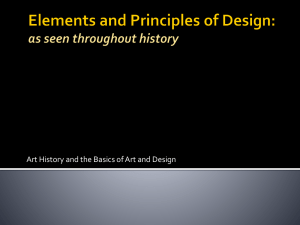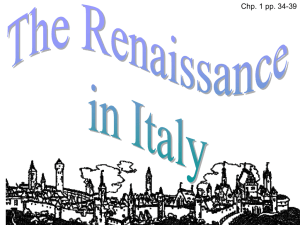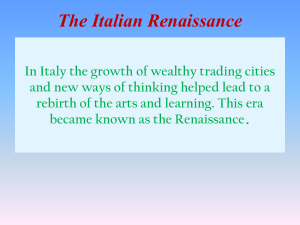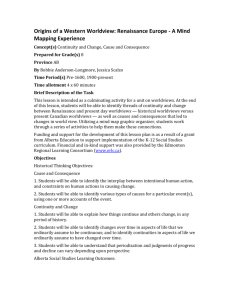Social Studies 8 Chapter 2
advertisement
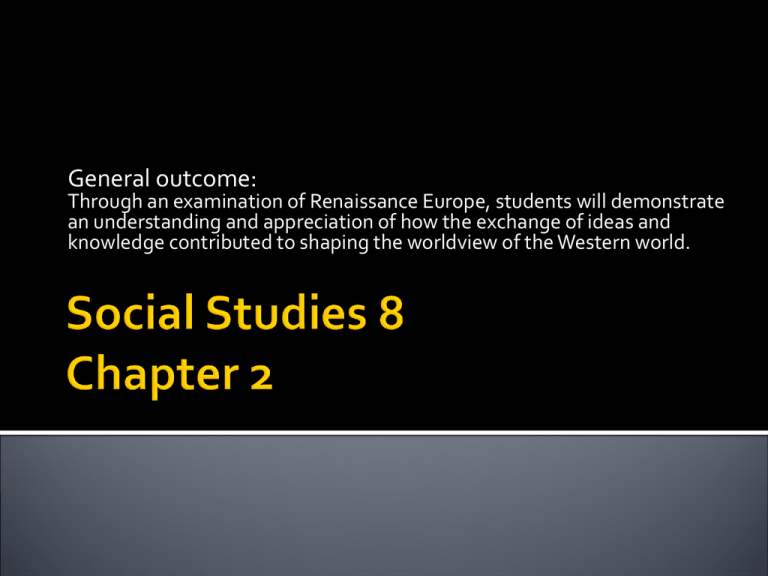
General outcome: Through an examination of Renaissance Europe, students will demonstrate an understanding and appreciation of how the exchange of ideas and knowledge contributed to shaping the worldview of the Western world. How did the Renaissance spark the growth and exchange of ideas and knowledge across Europe (i.e., astronomy, mathematics, science, politics, religion, arts)? In what ways did thinkers and philosophers influence society in the development of a humanist worldview during the Renaissance? Read the chapter title (page 48) Knowing what you already know, guess what ideas would have had the most impact on people, and how and where these ideas might have spread. Read the chapter introduction What types of people were involved in spreading the ideas of the Italian Renaissance? Define each type Discuss: What types of people are likely to influence the ideas of the modern-day western world, especially in Canada? Geographic reasons why the Renaissance was slow to spread to the rest of Europe? Create a picture diagram that summarizes why ideas were slow to spread Create a cause and effect diagram that summarizes the factors that made it possible for Renaissance ideas to spread quickly If you need help creating a cause and effect diagram look at the skills center in your textbook (pg. 369) Cause= the big event Effect= How the event helped the Renaissance spread quickly Please read pages 53-54 Reflect and respond #1-3 Possible meanings? Think of other words ending in ism Read pages 55-56, respond to question #1-2 Get into groups of 6-7 Grab a copy of the Jigsaw template. Decide amongst your group members who will be responsible for learning about each set of people As a group design the format that your group members will use to write their biographies (ie. What is important information to share?) Get into your expert groups 1. Scholars and Philosophers (pg. 57-59) 2. Artists (pg. 62-68) 3. Scientists and Mathematicians (pg. 69-71) 4. Writers (pg. 72-73) First read the relevant pages in the textbook taking notes and organizing information. Choose one person that you are going to do a bibliography on and use information from the textbook and the internet Work with the other experts in your group to complete the Reflect & Respond questions in your section Before we gather information on the internet….. Grab a “taking an Internet Field Trip” handout Each expert (or pair of experts) should make a presentation to the home group about the people they were studying As a group read pages 74-75 and answer Reflect & Respond #1-3 page 75. If you finish early, do you think it’s a good idea to read the pages that you didn’t read? Scholars travelled from one university to another to study and teach Northern Europeans wanted to learn more about humanism, so they left for Italian universities and brought humanist ideas and attitudes back home with them 1. Petrarch 2. Erasmus 3. Guillaume Bude 4. Michel de Montaigne Art for many people is the key change during the Renaissance New artistic styles were developed, techniques, and materials to coincide with changing worldviews Art during the renaissance reflected the new thinking of humanism Artists became more interested in the world around them Artists changed their painting styles dramatically, portraying humanist subject matter or religious works in humanist style Figures in religious renaissance art became more lifelike than ever before, with realistic human proportions and facial expressions Human dissection lead to more knowledge about the human body The world as it actually looked became a common background in paintings More portraits were being painted Art became marketable A lot of factors made it difficult for science and mathematics' to gain support: 1. Religion put the focus on afterlife; scientific questioning was discouraged 2. Europe very superstitious; believed in astrology and witchcraft 3. No money after arts were being sponsored 4. No university really encouraged it Soon scientists began asking questions and looking for the natural causes of events rather than accepting what had been determined. Used math and careful observations to develop a different theory of the universe Copernicus proved that earth was not the center of the universe, rather the sun was Views were considered heresy by church 100 years later his theory was accepted Began dissecting human cadavers once the Pope allowed it, to help physicians and artists He recorded numerous plans for inventions Considered a “Renaissance man” His work was built by Islamic scholars Solutions for doubling a cube, trisecting a triangle, useful for engineering and architecture Although Latin was the dominant language, some writers began to compose their works in their own vernacular languages. 1. Geoffrey Chaucer 2. Sir Thomas Moore 3. Francois Rabelais 4. William Shakespeare Grab a copy of the poetry handout and read the poems, when finished complete the handout The Renaissance- Art, Music and Literature (22 minutes) The Renaissance- Science and Invention (22 minutes) Review the model showing that Worldview Affects the way a Society operates (pg.9) Review the term: Quality of Life Read page 76-82 and respond to Question #2a pg. 80. The Renaissance-Everyday Life in the Renaissance (25 minutes) Please read page 86 and answer question #1 of the Review and Synthesize page 87.


